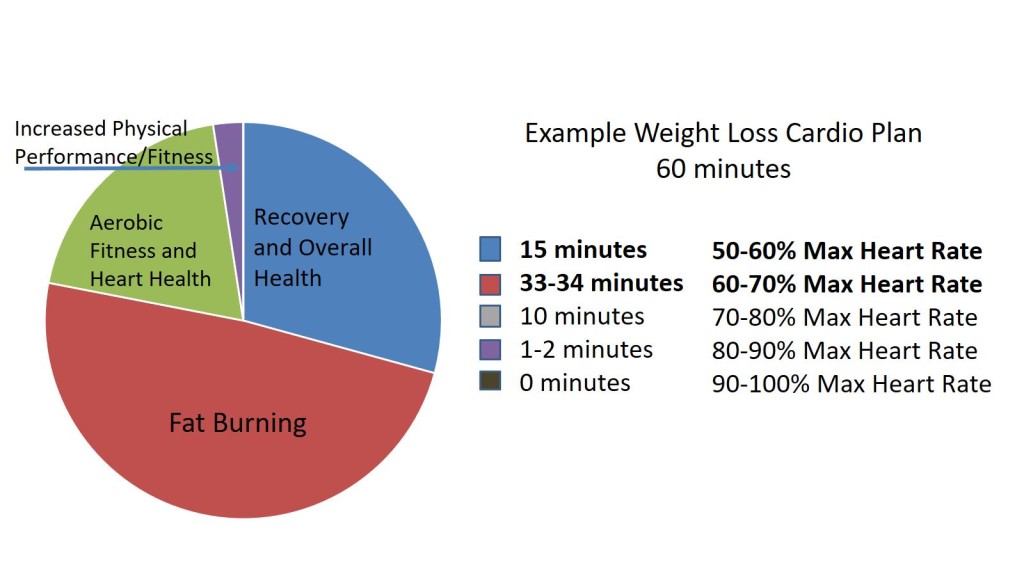There are a variety of benefits to cardio exercise such as improving heart health, stabilizing blood sugars and the mental boost that comes from being active. It’s true that some health benefits are achieved by just moving in any manner compared to being sedentary. If, however, you have a more specific goal in mind when you lace up your sneakers, it’s important to know how to achieve it.
For example, a weight-loss goal requires training in heart rate changes that are best for fat burning, whereas cardiorespiratory fitness usually requires higher intensities. The guide below can help take the guesswork out of training and allow you to make sure that your time is spent working toward your goals!
Use this Guide to Fuel Your Cardio Goals!
Goal: General Health and Recovery
When you first start moving after long periods of inactivity or after a surgical procedure, it is best to move slow and increase overall lifestyle activity. Though you’re technically burning fat at this stage, it’s not being burned at its fullest potential (most fat calories per minute of exercise). The health and recovery goal is about preparing your body for future movement at higher heart rates while reducing the risk of injury. Generally, the following exercises are associated to 50-60 percent of Maximum Heart Rate (MHR).
- Increased bouts of standing versus sitting
- Walking for chores or errands
- Accumulative small exercise bouts of 5-10 minutes
- Restorative yoga
- Flexibility exercises
Goal: Fat Burning and Basic Endurance
Since oxygen has to be readily available to burn fat, heart rates need to be lower overall at an intensity where it’s easy to breathe. Fat is a slow-burning fuel and a longer workout will be needed to maximize the amount of fat burned (versus a high intensity, short duration workout). Athletes or well-trained individuals are the exception as they can often burn fat at higher intensity levels. Generally, the following exercises are associated to 60-70 percent of MHR.
- Brisk walking outdoors or on a treadmill
- Riding a stationary bike
- Elliptical training (light-moderate)
- Water walking
Goal: Aerobic Fitness and Heart Health
This goal requires a harder workout than the fat-burning and basic endurance goal. Though you’ll likely reduce the amount of fat burned in a session, this type of training increases heart health. A stronger heart can work more effectively to deliver nutrient-rich blood to the body, making the heart more resilient against disease. Generally, the following exercises are associated to 70-80 percent of MHR.
- Jogging
- Elliptical (moderate intensity)
- Water aerobics
- Rower (light-moderate intensity)
- Dancing (R&B, slow)
- Bike riding (general)
Goal: Increased Physical Performance and Fitness
As your heart rate continues to climb, your anaerobic system will kick into gear, resulting in improved physical performance. Fat burning is minimal since your body will need to burn readily available fuel that requires a minimal amount of oxygen and carbohydrates. Your muscular system will be taxed and your body will be required to enhance its cardiorespiratory system to support this increased physical effort. Generally, the following exercises are associated to 80-90 percent of MHR.
- Running
- Rowing
- Dancing (techno, fast)
- Swimming laps
- Athletic cycling or Spin
Goal: Speed Training, Athletic Performance
This goal uses almost all carbohydrates to fuel short-term bouts of very high intensity exercise. It is best to have previous training experience in order to reap the benefits of this goal with less risk of injury. Generally, the following exercises are associated to 90-100 percent of MHR.
- HIIT (High Intensity Interval Training)
- Sprints (running, cycling, swimming, rowing, etc.)
- Tabata (periods of sprints mixed with rests)
If you have multiple goals, spend a small amount of time training for those too, but the most amount of time exercising at the rate intensity that reflects your primary goal. For example, see the chart below.
The exercises below are a quick way to see if you are exercising in a manner that matches your goals. Generally, an exercise intensity is referred to a percentage of heart rate maximum (HRM), like I have indicated in the description of each goal. Your HRM can be derived from a sub-maximal exercise test, but, at best, it’s an estimation of fuel utilization (where you burn fat vs. carbohydrates in exercise). The best way to determine how our body is burning calories is through a maximal fitness test such as VO2 testing. This type of testing measures oxygen utilization during exercise, identifying exactly where fat is being used as opposed to carbohydrates. This takes the guesswork out of cardio and maximizes the potential to reach your goals. Though these tests aren’t usually done in gym settings, they are becoming more popular in fitness studios and healthcare facilities. Overall, keep moving — and moving toward your goals!
Mira Rasmussen ASCM EP-C, is the founder and president of Fitness Beyond Training, which specializes in functional training for the general population, athletes and those managing disease or any physical limitations. Committed to promoting a healthy lifestyle, Mira serves on the Obesity Action Coalition’s Education Committee and frequently writes for Your Weight Matters Magazine. For more information on Mira, please visit www.fitnessbeyondtraining.com







